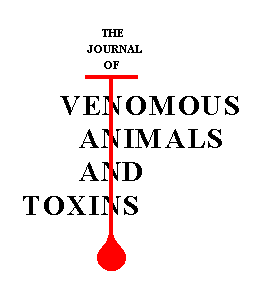Mini-Symposium - Abstracts
3 BOTHROPSTOXINS AND PIRATOXINS: STRUCTURE AND FUNCTION
A.C.O. CINTRA , L.C. MANCUSO
, L.C. MANCUSO , M.F. PEREIRA
, M.F. PEREIRA , M.H. TOYAMA
, M.H. TOYAMA , J.C. NOVELLO
, J.C. NOVELLO , S. MARANGONI
, S. MARANGONI , B. OLIVEIRA
, B. OLIVEIRA , J.R. GIGLIO
, J.R. GIGLIO
 Department of Biochemistry, School of Medicine, University of São Paulo, Ribeirão Preto, SP;
Department of Biochemistry, School of Medicine, University of São Paulo, Ribeirão Preto, SP; Department of Biochemistry, Institute of Biology, University of Campinas, Campinas, SP, Brazil.
Department of Biochemistry, Institute of Biology, University of Campinas, Campinas, SP, Brazil.
Among Brazilian venomous snakes, those of the genus Bothrops are outstanding since they are responsible for 85-90% of the ophidian accidents in this country. B. jararacussu, a bothropic snake, is found in several states from Central to Southern Brazil, while B. pirajai, morphologically very similar to B. jararacussu, is confined to Southern Bahia. Aiming at the study of the structure-function relationship of their phospholipase-A2 (PLA2)-like toxins, both venoms were fractionated by gel filtration on Sephadex G-75 and chromatography on SP-Sephadex C-25, yielding highly purified myotoxins, among them Bothropstoxin (BthTX)-I and II and Piratoxin (PrTX)-III. These are basic proteins of MW ~ 14,000 (~120 amino acid residues). Their complete amino acid sequences were determined both by the classical Edman-Dansyl procedure and by automatic sequential degradation, showing 60% homology between BthTX-I/BthTX-II and 77% between BthTX-II/PrTX-III. BthTX-I is a Lys-49 PLA2- like myotoxin and, as expected, showed no PLA2 activity upon egg-yolk phosphatidylcholine. PrTX-III has an Asp-49 and, not surprisingly, has PLA2 (besides a high anticoagulant) activity. BthTX-II, however, besides keeping Asp-49 and the strategic residues of the Ca loop and catalytic site, showed residual PLA2 activity. We conclude that this activity, under the conditions studied, greatly depends not only on the proposed Ca
loop and catalytic site, showed residual PLA2 activity. We conclude that this activity, under the conditions studied, greatly depends not only on the proposed Ca loop but on the new environment developed by other point mutations along the evolutionary process.
loop but on the new environment developed by other point mutations along the evolutionary process.
Financial support: CNPq, FAPESP, FAEPA and FAEP.
CORRESPONDENCE TO:
Dr. José Roberto Giglio - Faculdade de Medicina de Ribeirão Preto, Universidade de São Paulo, Departamento de Bioquímica, Av. Bandeirantes, 3900, CEP 14049-900, Ribeirão Preto, SP, Brasil. email: jrgiglio@uhura.fmrp.usp.br
Publication Dates
-
Publication in this collection
08 Jan 1999 -
Date of issue
1997

